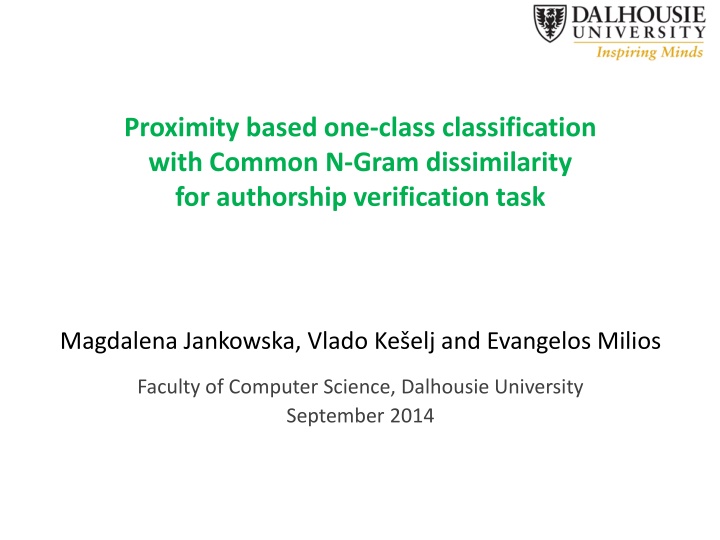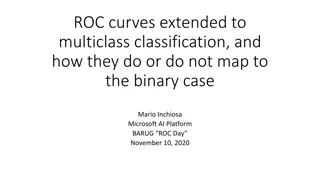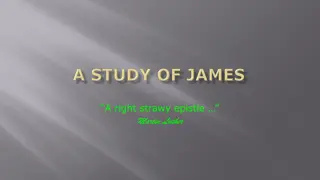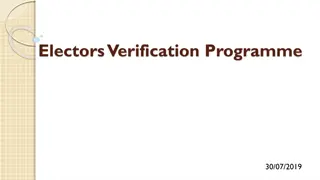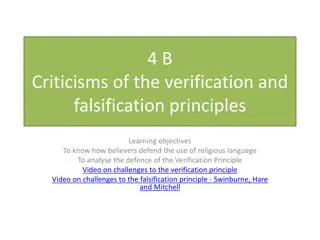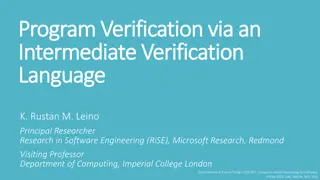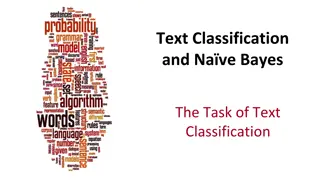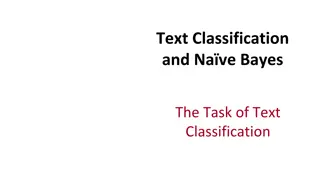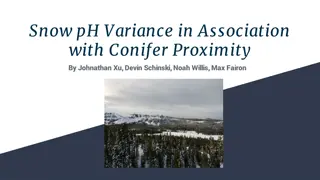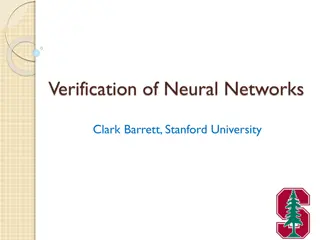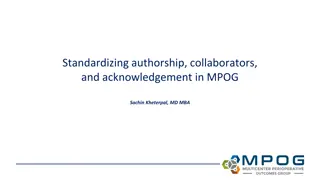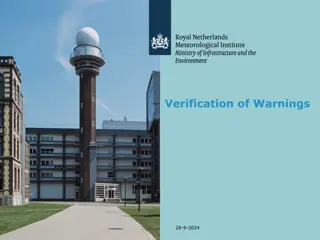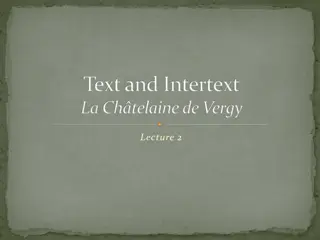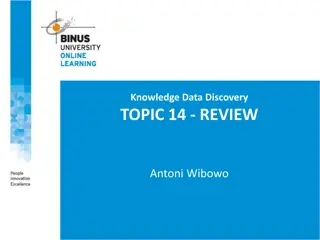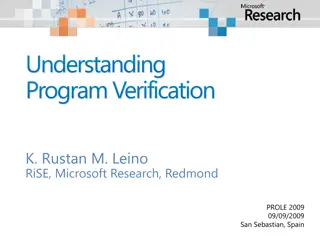Proximity-Based One-Class Classification for Authorship Verification
This research paper presents a proximity-based one-class classification approach for authorship verification tasks. The method utilizes Common N-Gram dissimilarity and aims to determine if a questioned document matches a set of known documents by a specific author. The study discusses the application of this approach in fields such as forensics, security, and literary research, highlighting the significance of authorship attribution in various contexts.
Download Presentation

Please find below an Image/Link to download the presentation.
The content on the website is provided AS IS for your information and personal use only. It may not be sold, licensed, or shared on other websites without obtaining consent from the author.If you encounter any issues during the download, it is possible that the publisher has removed the file from their server.
You are allowed to download the files provided on this website for personal or commercial use, subject to the condition that they are used lawfully. All files are the property of their respective owners.
The content on the website is provided AS IS for your information and personal use only. It may not be sold, licensed, or shared on other websites without obtaining consent from the author.
E N D
Presentation Transcript
Proximity based one-class classification with Common N-Gram dissimilarity for authorship verification task Magdalena Jankowska, Vlado Ke elj and Evangelos Milios Faculty of Computer Science, Dalhousie University September 2014
Example "The Cuckoo's Calling 2013 detective novel by Robert Galbraith
Example "The Cuckoo's Calling 2013 detective novel by Robert Galbraith Question by Sundays Times Was The Cuckoo s Calling really written by J.K. Rowling? Peter Millican and Patrick Juola requested (independently) to answer this question through their algorithmic methods Results indicative of the positive answer J. K. Rowling admitted that she is the author
Authorship verification problem Input: Set of known documents by a given author ? document of a questioned authorship unknown document ?
Authorship verification problem Input: Set of known documents by a given author ? document of a questioned authorship unknown document ? Question: Was u written by the same author?
Motivation Applications: Forensics Security Literary research
Our approach to the authorship verification problem Proximity-based one-class classification. Is u similar enough to A? Idea similar to the k-centres method for one-class classification Applying CNG dissimilarity between documents ? document of a questioned authorship unknown document ?
Common N-Gram (CNG) dissimilarity Proposed by Vlado Ke elj, Fuchun Peng, Nick Cercone, and Calvin Thomas. N-gram-based author profiles for authorship attribution. In Proc. of the Conference Pacific Association for Computational Linguistics, 2003. Proposed as a dissimilarity measure of the Common N-Gram (CNG) classifier for multi-class classification ? the least dissimilar class works of Carroll works of Shakespeare works of Twain Successfully applied to the authorship attribution problem
Character n-grams Character N-Grams Strings of n consecutive characters from a given text Alice was beginning to get very tired of sitting by her sister on the bank, and of having nothing to do: Alice's Adventures in the Wonderland by Lewis Carroll n=4 4-grams Alic 9
Character n-grams Character N-Grams Strings of n consecutive characters from a given text Alice was beginning to get very tired of sitting by her sister on the bank, and of having nothing to do: Alice's Adventures in the Wonderland by Lewis Carroll n=4 4-grams Alic lice 10
Character n-grams Character N-Grams Strings of n consecutive characters from a given text Alice was beginning to get very tired of sitting by her sister on the bank, and of having nothing to do: Alice's Adventures in the Wonderland by Lewis Carroll n=4 4-grams Alic lice ice_ 11
Character n-grams Character N-Grams Strings of n consecutive characters from a given text Alice was beginning to get very tired of sitting by her sister on the bank, and of having nothing to do: Alice's Adventures in the Wonderland by Lewis Carroll n=4 4-grams Alic lice ice_ ce_w 12
CNG dissimilarity - formula Profile a sequence of L most common n-grams of a given length n
CNG dissimilarity - formula Profile a sequence of L most common n-grams of a given length n Example for n=4, L=6 document 1: Alice'sAdventures in the Wonderland by Lewis Carroll profile ?? n-gram normalized frequency ?? 0.0127 _ t h e t h e _ 0.0098 a n d _ 0.0052 _ a n d 0.0049 i n g _ 0.0047 _ t o _ 0.0044
CNG dissimilarity - formula Profile a sequence of L most common n-grams of a given length n Example for n=4, L=6 document 1: Alice'sAdventures in the Wonderland by Lewis Carroll document 2: Tarzan of theApes by Edgar Rice Burroughs profile ?? profile ?? normalized frequency n-gram normalized frequency ?? 0.0127 n-gram ?? _ t h e _ t h e 0.0148 t h e _ 0.0098 t h e _ 0.0115 a n d _ 0.0052 a n d _ 0.0053 _ a n d 0.0049 _ o f _ 0.0052 i n g _ 0.0047 _ a n d 0.0052 _ t o _ 0.0044 i n g _ 0.0040
CNG dissimilarity - formula Profile a sequence of L most common n-grams of a given length n Example for n=4, L=6 document 1: Alice'sAdventures in the Wonderland by Lewis Carroll document 2: Tarzan of theApes by Edgar Rice Burroughs profile ?? CNG dissimilarity between these documents profile ?? normalized frequency n-gram normalized frequency ?? 0.0127 n-gram 2 ?1? ?2? ?1? + ?2? 2 ?? ? = _ t h e _ t h e 0.0148 ? ?1 ?2 t h e _ 0.0098 t h e _ 0.0115 where ??? = 0 if ? does not appear in ?? a n d _ 0.0052 a n d _ 0.0053 _ a n d 0.0049 _ o f _ 0.0052 i n g _ 0.0047 _ a n d 0.0052 _ t o _ 0.0044 i n g _ 0.0040
Proximity-based one-class classification: dissimilarity between instances Set of known documents by a given author Dissimilarity between a given known document and the unknown document ? ?? ? ??,? unknown document ?
Proximity-based one-class classification: dissimilarity between instances Set of known documents by a given author Dissimilarity between a given known document and the unknown document ? ?? ? ??,? Maximum dissimilarity between ?? and any known document unknown document ? ??????,? this author s document most dissimilar to ??
Proximity-based one-class classification: dissimilarity between instances Dissimilarity ratio of ?? : How much more/less dissimilar is the unknown document than the most dissimilar document by the same author. ? ??,? ??????,? ? ??,?,? = ? ?? ? ??,? ? ??????,? this author s document most dissimilar to ??
Proximity-based one-class classification: proximity between a sample and the positive class instances Measure of proximity between the unknown document and the set A of documents by a given author: ? ?,? - average of dissimilarity ratios ? ??,?,? over all known documents ?? ? ? ?,? unknown document ?
Proximity-based one-class classification: thresholding on the proximity Iff ? ?,? less than or equal to a threshold : classify u as belonging to A ? ? ?,? unknown document ? Was ?written by the same author? Yes, iff ? ?,? < ?
Confidence scores Obtained by linear scaling the ? ?,? measure: the threshold ? 0.5 with a cut-off at ? : ? ?,? < ? 1 ? ?,? > ? + 0
Parameters Parameters of our method: n n-gram length L profile length: number of the most common n-grams considered threshold for the proximity measure M for classification
Proximity-based one-class classification: special conditions used Dealing with instances when only 1 known document by a given author is provided: dividing the single known document into two halves and treating them as two known documents Dealing with instances when some documents do not have enough character n-grams to create a profile of a chosen length: representing all documents in the instance by equal profiles of the maximum length for which it is possible Additional preprocessing (tends to increase accuracy on training data): cutting all documents in a given instance to an equal length in words
Ensembles Ensembles combine classifiers that differ between each other with respect to at least one of the three document representation parameters: type of the tokens for n-grams (word or character) size of n-grams length of a profile Aggregating results by majority voting or voting weighted by confidence score by a classifier
Testbed1: PAN 2013 competition dataset PAN 2013 9th evaluation lab on uncovering plagiarism, authorship, and social software misuse Author Identification task: Author Verification problem instances in English, Greek and Spanish
Competition submission: a single classifier Parameters for the competition submission selected using experiments on training data in Greek and English: provided by the competition organizers compiled by ourselves from existing datasets for other authorship attribution problems For Spanish: the same parameters as for English English Spanish Greek n (n-gram length) 6 7 L (profile length) 2000 2000 (threshold) if at least two known documents given 1.02 1.008 (threshold) if only one known document given 1.06 1.04
Results of PAN 2013 competition submission Entire set English subset Greek subset Spanish subset Evaluation measure: F1 (identical to accuracy for our method) (18 teams) F1 of our method 0.659 0.733 competition rank 5th (shared) of 18 of 18 0.600 7th (shared) of 16 0.640 5th (shared) 9th of 16 best F1 of other competitors 0.753 0.800 0.833 0.840 Secondary competition evaluation measure: AUC (10 teams) AUC 0.777 0.842 0.711 0.804 1st of 10 1st of 10 2nd of 10 2nd of 10 competition rank Best AUC of 9 other participants 0.735 0.837 0.824 0.926
Evaluation of ensembles on PAN 2013 dataset (after contest) Selected experimental results for ensembles Entire set English subset Spanish subset Greek subset Acc. AUC Acc. AUC Acc. AUC Acc. AUC Our ensembles: weighted voting, all classifiers in the considered parameter space character based 0.729 0.764 0.833 0.830 0.800 0.859 0.567 0.582 character and word based 0.741 0.780 0.800 0.842 0.840 0.853 0.600 0.622 Our ensemble: weighted voting, classifiers selected based on performance on train data character and word based 0.788 0.805 0.800 0.857 0.840 0.853 0.733 0.687 Methods by other PAN 13 participants (different methods in different columns) best results over other participants 0.753 0.735 0.800 0.837 0.840 0.926 0.833 0.824
Evaluation on PAN 2014 author verification competition Difference in dataset as compared to PAN 2013: fewer known documents per problem (max 5), in particular two datasets where only one known document is given per problem more problems in testing and training set more data categories: languages: English, Dutch, Spanish, Greek different genre categories
Our submission to PAN 2014 competition Separate ensemble for each category (language&genre combination) Ensembles selected based on performance on training data: fixed odd number of 31 classifiers with the best AUC Threshold set to the average of optimal thresholds of the selected classifiers on the train data (thresholds on which maximum accuracy achieved)
Results on PAN 2014 dataset: articles in Greek and Spanish Greek articles our competition rank: 5th of 13 Product of AUC and c@1 AUC c@1 our submission 0.497 0.731 0.680 result of the top participant 0.720 0.889 0.810 Spanish articles our competition rank: 3rd of 13 Product of AUC and c@1 AUC c@1 our submission 0.586 0.803 0.730 result of the top participant 0.698 0.898 0.778
Results on PAN 2014 dataset: Dutch essays and reviews Dutch essays our competition rank: 6th of 13 Product of AUC and c@1 AUC c@1 our submission 0.732 0.869 0.842 result of the top participant 0.823 0.932 0.883 Dutch reviews our competition rank: 5th of 13 Product of AUC and c@1 AUC c@1 our submission 0.357 0.638 0.560 result of the top participant 0.525 0.757 0.694
Results on PAN 2014 dataset: English essays and novels English essays our competition rank: 12th of 13 Product of AUC and c@1 AUC c@1 our submission 0.284 0.518 0.548 result of the top participant 0.513 0.723 0.710 English novels our competition rank: 13th of 13 Product of AUC and c@1 AUC c@1 our submission 0.225 0.491 0.457 result of the top participant 0.508 0.711 0.715
Results on PAN 2014 dataset: entire data set PAN 2014 entire data set our competition rank: 9th of 13 Product of AUC and c@1 AUC c@1 our submission 0.367 0.609 0.602 result of the top participant 0.490 0.718 0.683
Discussion of results on PAN 2013 and PAN 2014 datasets The ensembles of word-based and character based classifiers with weighted voting and that used the training data were tested on both PAN 2013 and PAN 2014 sets Our method is best suited for problems with at least 3 known documents (as it takes advantage of the pair of the most dissimilar known documents). On all evaluation sets in which the average number of known documents is at least 3 per problem, the results were satisfactory (corresponding to the 3rd or higher competition rank): PAN 2013 entire set PAN 2013 English set PAN 2013 Spanish set PAN 2013 Greek set PAN 2014 Spanish articles set Problems with only one known documents are very challenging for our method. On the two datasets for which the number of known documents was 1 per problem, the results were very poor: PAN 2014 English novels PAN 2014 Dutch reviews More investigation is needed for explaining the extremely poor performance on PAN 2014 English essays. One special feature of this set is that is the only one where the authors are not native speakers
Conclusion An intrinsic one-class proximity based classification for authorship verification Evaluated on datasets of PAN 2013 and PAN 2014 author verification competition: competitive results for sets with the average number of documents of known authorship is at least 3 Poor results on problems with only 1 document of known authorship Ensembles of character based and word based classifiers seems to work best
Future work Better adaptation of the method for the problems where only one known document is present Investigating dividing known documents into more chunks instead of just two. This may also be applied and possibly improve the performance for cases when 2 known documents are present analysis of the role of word n-grams and character n-grams depending on the genre of the texts, and on the topical similarity between the documents
